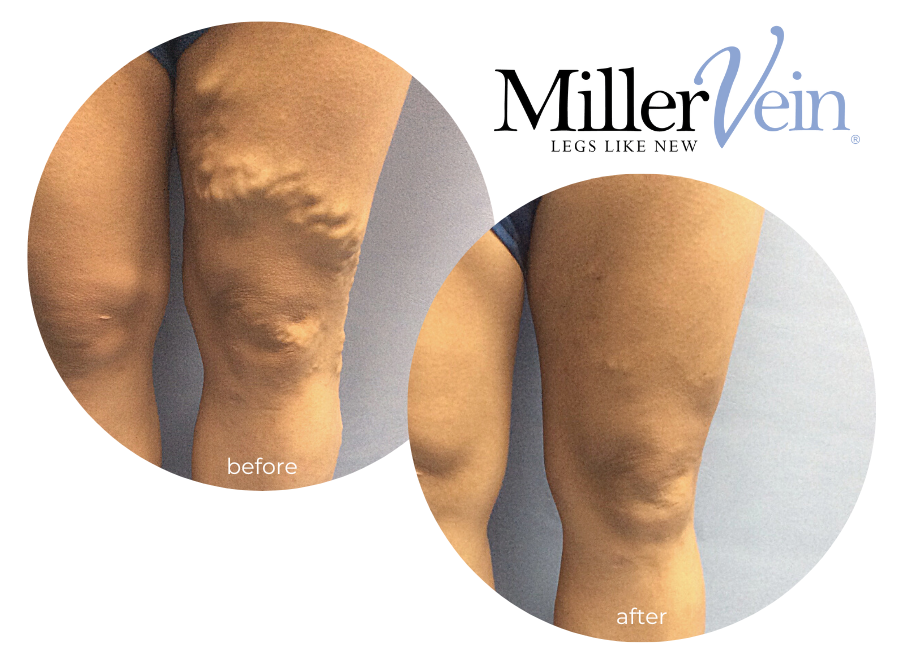
Varicose Vein Treatment
Varicose veins are abnormally enlarged veins at the surface of your skin which appear bulged, twisted, or ropey. Diagnosis and treatment of varicose veins is frequently covered by insurance.
Normally, veins carry blood from your legs up to your heart using one-way valves. When veins get weak, these valves no longer function, and blood may flow backward towards your feet. This abnormal flow is called venous reflux or venous insufficiency. Pooled blood leads to varicose veins, spider veins and a variety of symptoms.
More than 80 million Americans suffer from vein disorders such as varicose and spider veins. An estimated 40% of women and 25% of men will experience symptoms such as pain, aching, swelling, heaviness, and fatigue due to their veins.
When you make the decision to visit Miller Vein, you’ll talk to a board-certified vein specialist, with the talent and expertise to provide the individualized care you deserve. We create a treatment plan for your specific needs, take the time to fully inform you about the procedure, and provide follow-up care designed around you.
“I cannot even begin to explain how much my legs have changed for the better. Those unsightly varicose veins are disappearing before my eyes. I will actually start wearing shorts again.”
– J.S., Miller Vein Patient
Treatment Methods
At Miller Vein, our experienced physicians specialize in the treatment of varicose veins and are well-versed in the latest techniques and technologies. No surgery, no downtime, and no scars. You can drive yourself to and from treatment and get back to enjoying your life.
Thermal Ablation
There are two types of thermal ablation. In laser ablation, a thin laser fiber is inserted into the affected vein, and laser energy is used to heat and close the vein. In radiofrequency ablation (RFA), a thin catheter is inserted, and radiofrequency energy is used to heat and close the vein. Once the vein is closed, circulation improves as blood is naturally rerouted to healthy veins.
VenaSeal™
The VenaSeal™ system improves blood flow by closing diseased veins with a specially formulated medical adhesive. A special catheter system delivers a small amount of the adhesive to the diseased vein. The vein is sealed, and blood is rerouted through nearby healthy veins.
Sclerotherapy
Also known as endovenous chemical ablation, sclerotherapy treatment uses an FDA-approved medicine to close down abnormal veins. The medicine can be made stronger by making it into a foam. Some patients only need a single treatment although additional treatments may be needed, depending on the number and size of veins.
Mechanochemical Ablation
Mechanochemical ablation is a minimally invasive treatment for varicose veins that involves using a small catheter (ClariVein®) to deliver medication to the affected vein. Once the catheter is inserted into the vein, a rotating wire tip is activated, which disperses a medication that irritates the lining of the vein, causing it to quickly close. Once the vein is closed, the body naturally reroutes blood flow to healthier veins.
Microphlebectomy
Also referred to as ambulatory phlebectomy, microphlebectomy is a safe and effective in-office procedure that is used to remove varicose veins through tiny incisions using local anesthetic. These incisions are so small that no sutures or stitches are required. Once removed, these varicose veins never return.
“I’m so glad I found Miller Vein, after searching other places, I was confident once I had my consultation. If you’re looking to have your varicose vein treated look no further, the staff were complete professionals.”
– C.C., Miller Vein Patient
“The doctors and staff here are exceptional. My procedures were quick, painless and always timely and post-procedure instructions were clear and concise.”
– S.B., Miller Vein Patient
Frequently Asked Questions
What causes varicose veins?
Normally, veins carry blood from your legs up to your heart using one-way valves. When veins get weak, these valves no longer function, and blood may flow backward towards your feet. This abnormal flow is called venous reflux or venous insufficiency. Pooled blood leads to varicose veins, spider veins and a variety of symptoms.
What are symptoms of varicose veins?
In addition to unsightly veins, you may experience additional symptoms. Lower extremity pain, swelling, aching, heaviness, throbbing, fatigue, restless legs, and night cramps are all symptoms of chronic venous insufficiency. Left untreated skin changes and ulcers can also occur.
Are varicose veins dangerous?
Varicose veins can cause a range of mild to severe symptoms, and in severe cases, they may lead to the development of open sores or ulcers on the legs or feet. They can also be a risk factor for developing blood clots.
Is varicose vein treatment covered by insurance?
Treatment is covered by most insurance plans, including Medicare. Miller Vein accepts over 700 plans and will work with insurance companies on your behalf.
How long does varicose vein surgery take?
In most cases, varicose vein procedures can be performed in 30 minutes or less. You can return to normal activity the same day of your procedure, with little or no pain.
What is the downtime after a varicose vein procedure?
There is no downtime. You can drive yourself to and from the procedure. There will be minor restrictions for a couple days: no sun exposure, soaking in water, or use of lotions for example.
What kind of results can I expect?
In general, patients can expect to see a significant improvement in how their legs feel shortly after treatment.
What kind of follow-up care will I need after varicose vein surgery?
After your procedure, we will schedule a one-week follow-up to check that your veins have closed, and we will also screen for blood clots. We will schedule follow-up visits over the twelve months after a procedure. Vein disease is chronic, during follow-up appointments, we will see if you have symptoms that could indicate other veins have become affected.

